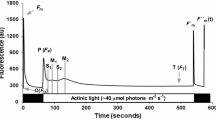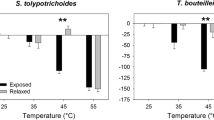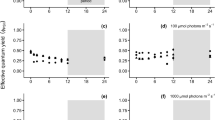Abstract
The effect of acclimation to 25, 18, or 10° C on the relationship between photoprotection and photodamage was tested in low-light-grown (80 μmol · m−2 · s−1) Ulva rotundata Blid. exposed to several higher irradiances at the acclimation temperature. Changes in chlorophyll fluorescence parameters (minimum fluorescence, F0, and the ratio of variable to maximum fluorescence, Fv/Fm, measured after 5 min darkness) were monitored during 5 h transfers to 350, 850, and 1700 μmol · m−2 · s−1, and during recovery after 1- or 5-h treatments. At all temperatures, rate of onset and final extent of photoinhibition, measured by a decrease in Fv/Fm, increased with increasing irradiance. At a given photoinhibitory irradiance, rate of onset was most rapid at 10 ° C, but the extent was temperature-independent. Recovery rates from mild light stress were similar at all temperatures, but recovery from the most extreme photoinhibitory treatment lagged 2 h at 10° C. De-epoxidation of xanthophyll-cycle components proceeded faster and to a lower epoxidation status at 25° C, but there was little difference in the pool size among the three growth conditions. Using chloramphenicol to inhibit chloroplast protein synthesis and dithiothreitol to inhibit violaxanthin de-epoxidation, it was shown that at the lowest light treatment given, the extent of photoinhibition could be attributed both to greater amounts of photodamage and to greater zeaxanthin-related photoprotection at 25 than at 10° C. While these two mechanisms for high-light-induced loss of photosynthetic efficiency were operating at 10° C, there was evidence for a relatively greater proportion of zeaxanthin-unrelated photoprotection at the low temperature. This photoprotective mechanism is related to a rapidly reversible increase in F0 and is insentivite to both chloramphenicol and dithiothreitol.
Similar content being viewed by others
Abbreviations
- CAP:
-
chloramphenicol
- DTT:
-
dihiothreitol
- F0, Fm, Fv :
-
minimum, maximum, and variable fluorescence
- Φ :
-
quantum yield
References
Aro, E.-M., Hundal, T., Carlberg, I., Andersson, B. (1990) In-vitro studies on light-induced inhibition of photosystem II and D1 protein degradation at low temperatures. Biochim. Biophys. Acta 1019, 269–275
Bilger, W., Björkman, O. (1991) Temperature dependence of violaxanthin de-epoxidation and non-photochenical fluorescence quenching in intact leaved of Gossypium hirsutum L. and Malva parviflora L. Planta 184, 226–234
Chow, W.S., Osmond, C.B., Huang, L.K. (1989) Photosystem II function and herbicide binding sites during photoinhibition of spinach chloroplasts in vivo and in vitro. Photosynth. Res. 21, 17–26
Demmig-Adams, B. (1990) Carotenoids and photoprotection in plants: A role for the xanthophyll zeaxanthin. Biochim. Biophys. Acta 1020, 1–24
Demmig-Adams, B., Adams, W.W., III. (1992) Photoprotection and other responses of plants to high light stress. Annu. Rev. Plant Physiol. Plant Mol. Biol. 43, 599–626
Falk, S., Samuelsson, G., Öquist, G. (1990) Temperature-dependent photoinhibition and recovery of photosynthesis in the green alga Chlamydomonas reinhardtii acclimated to 12 and 27° C. Physiol. Plant. 78, 173–180
Franklin, L., Levavasseur, G., Osmond, C.B., Henley, W.J., Ramus, J. (1992) Two components of onset and recovery during photoinhibition of Ulva rotundata. Planta 186, 399–408
Gilmore, A.M., Yamamoto, H.Y. (1991) Resolution of lutein and zeaxanthin using a nonendcapped, lightly carbon loaded C-18 high-performance liquid chromatographic column. J. Chromatogr. 543, 137–145
Gong, H., Nilsen, S. (1989) Effect of temperature on photoinhibition of photosynthesis, recovery, and turnover of the 32kD chloroplast protein in Lemna gibba. J. Plant Physiol. 135, 9–14
Greer, D.H., Berry, J.A., Björkman, O. (1986) Photoinhibition of photosynthesis in intact bean leaves: role of temperature, and requirement for chlotoplast-protein synthesis during recovery. Planta 168, 253–260
Greer, D.H., Laing, W.A., Kipnis, T. (1988) Photoinhibition of photosynthesis in intact kiwifruit Actinidia deliciosa leaves: Effect of temperature. Planta 174, 152–158
Greer, D.H., Laing, W.A. (1988) Photoinhibition of photosynthesis in intact kiwifruit Actinidia deliciosa leaves, recovery and its dependence on temperature. Planta 174, 159–165
Greer, D.H., Ottander, C., Öquist, G. (1991) Photoinhibition and recovery of photosynthesis in intact barley leaves at 5 and 20° C. Physiol. Plant. 81, 203–210
Guillard, R.R.L., Ryther, J.H. (1962) Studies of marine planktonic diatoms. I. Cyclotella nana Husted and Dentonula conferracea (Cleve). Gran. Can. J. Microbiol. 8, 229–239
Heifetz, P., Lers, A., Boynton, J., Gilham, N., Osmond, B. (1992) Photosynthetic consequences of specific chloroplast gene mutations affecting function and sunthesis of the PSII D-1 protein. In: Research in photosynthesis, pp. 417–420, Murata, N. ed. Kluwer Academic Publishers, Netherlands
Henley, W.J. (1992) Growth and photosynthesis of Ulva rotundata (Chlorophyta) as a function of temperature and square wave irradiance in indoor culture. J. Phycol. 28, 625–634
Henley, W.J., Levavasseur, G., Franklin, L.A., Osmond, C.B., Ramus, J. (1991) Photoacclimation and photoinhibition in Ulva rotundata as influenced by nitrogen availability. Planta 184, 235–243
Hundal, T., Aro, E.-M., Carlberg, L, Anderson, B. (1990) Restoration of light induced photosystem II inhibition without de novo protein synthesis. FEBS Lett. 267, 203–206
Hurry, V.M., Krol, M., Öquist, G., Huner, N.P.A. (1992) Effect of long-term photoinhibition on growth and photosynthesis of cold-hardened spring and winter wheat. Planta 188, 369–375
Kirilovsky, D., Etienne, A.-L. (1991) Protection of reaction center II from photodamage by low temperature and anaerobiosis in spinach chloroplasts. FEBS Letts. 279, 201–204
Kirilovsky, D., Vernotte, C., Etienne, A.-L. (1990) Protection from photoinhibition by low temperature in Synechocystis 6714 and in Chlamydomonas reinhardtii: detection of an intermediary state. Biochem. 29, 8100–8106
Krause, G.H. (1988) Photoinhibition of photosynthesis. An evaluation of damaging and protective mechanisms. Physiol. Plant. 74, 566–574
Kyle, D.J. (1987) The biochemical basis for photoinhibition of photosystem II. In: Photoinhibition, pp. 197–226, Kyle, D.J., Osmond, C.B., Arntzen, C.J., eds. Elsevier, Amsterdam
Nultsch, W., Bittersmann, E., Holzwarth, A.R., Agel, G. (1990) Effects of strong light irradiation on antennae and reaction centers on the cyanobacterium Anabaena variabilis: a timeresolved fluorescence study. J. Photochem. Photobiol. (B) 5, 481–494
Ohad, I., Kyle, D.J., Arntzen, C.J. (1984) Membrane protein damage and repair: Removal and replacement of inactivated 32kilodalton polypeptides in chloroplast membranes. J. Cell Biol. 99, 481–485
Okada, K., Satoh, K., Katoh, S. (1991) Chloramphenicol is an inhibitor of photosynthesis. FEBS Lett. 295, 155–158
Öquist, G., D.H. Greer, Ögren, E. (1987) Light stress at low temperature. In: Photoinhibition, pp. 67–88, Kyle, D.J., Osmond, C.B., Arntzen, C.J., eds. Elsevier, Amsterdam
Öquist, G., Chow, W.S., Anderson, J.M. (1992) Photoinhibition of photosynthesis represents a mechanism for the long-term regulation of photosystem II. Planta 186, 450–460
Osmond, C.B. (1981) Photorespiration and photoinhibition. Some implications for the energetics of photosynthesis. Biochim. Biophys. Acta 639, 77–98
Osmond, C.B., Ramus, J., Levavasseur, G., Franklin, L.A., Henley, W.J. (1993) Fluorescence quenching during photosynthesis and photoinhibition of Ulva rotundata Blid. Planta 190, 97–106
Porra, R.J., Thompson, W.A., Kriedemann, P.E. (1989) Determination of accurate extinction coefficients and simultaneous equations for assaying chlorophylls a and b extracted with four different solvents: verification of the concentration of chlorophyll standards by atomic absorption spectroscopy. Biochim. Biophys. Acta 975, 384–394
Prásil, O., Adir, N., Ohad, I. (1992) Dynamics of photosystem II: mechanism of photoinhibition and recovery processes. In: The photosystems: structure, function and molecular biology, pp. 295–348, Barber, J. ed., Elsevier, Amsterdam
Schöner S., Krause, G.H. (1990) Protective systems against active oxygen species in spinach: response to cold acclimation in excess light. Planta 180, 383–389
Schreiber, U., Schliwa, U., Bilger, W. (1986) Continuous recording of photochemical and nonphotochemical chlorophyll fluorescence quenching with a new type of modulation fluorometer. Photosynth. Res. 10, 51–62
Šetlík, I., Allakhverdiev, S.I., Nedbal, L., Šetliková, L. Klimov, V.V. (1990) Three types of photosystem II photoinactivation. 1. Damaging processes on the acceptor side. Photosynt. Res. 23, 39–48
Somersalo, S., Krause, G.H. (1990) Reversible photoinhibition of unhardened and cold-acclimated spinach leaves at chilling temperatures. Planta 180, 181–187
Weis, E., Berry, J.A. (1987) Quantum efficiency of photosystem II in relation to energy-dependent quenching of chlorophyll fluorescence. Biochim. Biophys. Acta 894, 198–208
Author information
Authors and Affiliations
Additional information
This research was conducted in partial fulfillment of the requirements for the Ph. D. degree in the Department of Botany, Duke University. The author wishes to thank E.-M. Aro, W.J. Henley, G. Levavasseur, C.B. Osmond, and J. Ramus for helpful discussions, and C. Lovelock for pigment standards. Funding was provided by Grants-in-Aid of Research from Sigma Xi and the Phycological Society of America, and a Lynde and Harry Bradley Foundation Fellowship to L.A.F., and National Science Foundation grant OCE-8812157 to C.B.O. and J.R.
Rights and permissions
About this article
Cite this article
Franklin, L.A. The effects of temperature acclimation on the photoinhibitory responses of Ulva rotundata Blid.. Planta 192, 324–331 (1994). https://doi.org/10.1007/BF00198567
Received:
Accepted:
Issue Date:
DOI: https://doi.org/10.1007/BF00198567




